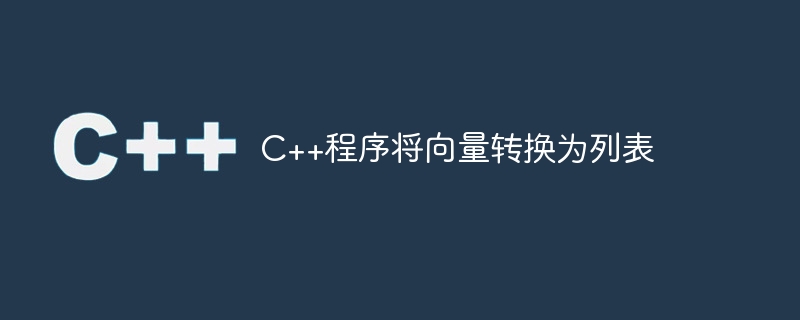
C++ 中的向量是动态数组,可以包含任何类型的数据,可以是用户定义的或原始的。动态是指向量的大小可以根据操作增加或减少。向量支持各种函数,数据操作非常容易。另一方面,列表是与向量相同的容器,但与向量的数组实现相比,列表实现是基于双向链表的。列表在其中的任何位置都提供相同的恒定时间操作,这是使用列表的主要功能。我们来看看将向量转换为列表的主要方法。
要使用范围构造函数,在创建列表时必须将向量的起始指针和结束指针作为参数传递给构造函数。
vector <int> ip; list <int> op( ip.begin(), ip.end() );
#include <iostream>
#include <vector>
#include <list>
using namespace std;
list <int> solve( vector <int> ip) {
//initialise the list
list <int> op( ip.begin(), ip.end() );
return op;
}
int main() {
vector <int> ip( { 15, 20, 65, 30, 24, 33, 12, 29, 36, 58, 96, 88, 30, 71 } );
list <int> op = solve( ip );
//display the input
cout<< "The input vector is: ";
for( int i : ip ) {
cout<< i << " ";
}
//display the output
cout << "\nThe output list is: ";
for( int j : op ) {
cout << j << " ";
}
return 0;
}
The input vector is: 15 20 65 30 24 33 12 29 36 58 96 88 30 71 The output list is: 15 20 65 30 24 33 12 29 36 58 96 88 30 71
std::list的用法与范围构造函数的用法类似。我们以与范围构造函数相同的方式传递向量的起始和结束指针。
vector <int> ip; list <int> op(); op.assign(ip.begin(), ip.end());
#include <iostream>
#include <vector>
#include <list>
using namespace std;
list <int> solve( vector <int> ip) {
//initialise the list
list <int> op;
op.assign( ip.begin(), ip.end() );
return op;
}
int main() {
vector <int> ip( { 40, 77, 8, 65, 92 ,13, 72, 30, 67, 12, 88, 37, 18, 23, 41} );
list <int> op = solve( ip );
//display the input
cout<< "The input vector is: ";
for( int i : ip ) {
cout<< i << " ";
}
//display the output
cout << "\nThe output list is: ";
for( int j : op ) {
cout << j << " ";
}
return 0;
}
The input vector is: 40 77 8 65 92 13 72 30 67 12 88 37 18 23 41 The output list is: 40 77 8 65 92 13 72 30 67 12 88 37 18 23 41
我们可以使用列表的插入函数将数据从向量插入到列表中。列表需要列表开头的指针以及向量开头和结尾的指针。
vector <int> ip; list <int> op(); op.insert(op.begin(), ip.begin(), ip.end());
#include <iostream>
#include <vector>
#include <list>
using namespace std;
list <int> solve( vector <int> ip) {
//initialise the list
list <int> op;
op.insert( op.begin(), ip.begin(), ip.end() );
return op;
}
int main() {
vector <int> ip( { 30, 82, 7, 13, 69, 53, 70, 19, 73, 46, 26, 11, 37, 83} );
list <int> op = solve( ip );
//display the input
cout<< "The input vector is: ";
for( int i : ip ) {
cout<< i << " ";
}
//display the output
cout << "\nThe output list is: ";
for( int j : op ) {
cout << j << " ";
}
return 0;
}
The input vector is: 30 82 7 13 69 53 70 19 73 46 26 11 37 83 The output list is: 30 82 7 13 69 53 70 19 73 46 26 11 37 83
在C++中,将向量转换为列表具有在列表的任何位置上统一的操作复杂度的好处。有几种方法可以将向量转换为列表。然而,我们只在这里提到了最简单和最快的方法。
以上是C++程序将向量转换为列表的详细内容。更多信息请关注PHP中文网其他相关文章!




